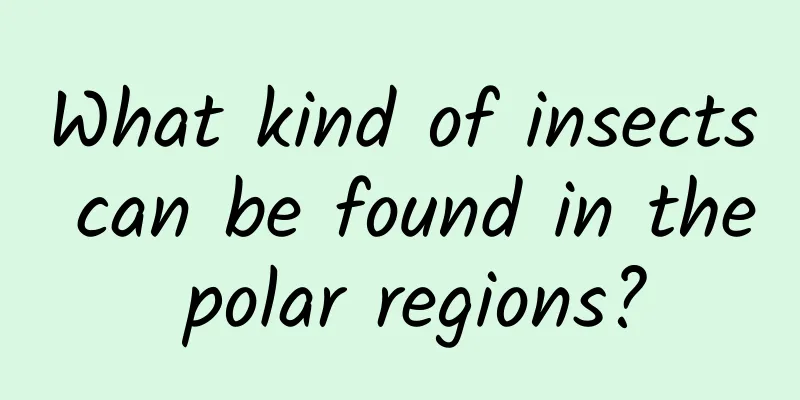What kind of insects can be found in the polar regions?

|
Source: www.maxpixel.net Insects are found almost all over the world, including in the harsh polar regions. + Polar insect groups+ Source: www.thoughtco.com In the polar regions where there are few humans and the environment is harsh, we can find many insects active. Scientists have comprehensively reported on insects in the Arctic tundra, discovering a total of 3,300 species of insects, including 1,600 species of Diptera, 450 species of beetles, 400 species of butterflies, 450 species of Hymenoptera, and some other insect species. Undoubtedly, Diptera accounts for the largest proportion of insects in the Arctic tundra, and they are also the most differentiated group in the class Insecta in polar environments. Source: midge.cfans.umn.edu Diamesa sp. For example, Diamesa insects of the Chironomid family are found throughout the Arctic, and some species can even survive in temperatures of -16°C. Source: midge.cfans.umn.edu Diamesa leona Their larvae typically grow and develop in cold water with high dissolved oxygen concentrations, feeding on periphyton (such as algae) that grow on rocks, wood, and other substrates in streams. Source: www.sci-news.com Chironomids antarctica The Antarctic midge Belgica antarctica lives on the rocks of the Antarctic Peninsula. It is a wingless insect and a completely terrestrial animal unique to the continent. Source: en.wikipedia.org Their larvae develop during the Antarctic winter, losing nearly half their body weight each time they dehydrate, and the adult lifespan is 7 to 10 days, during which time they mate and lay eggs. Source: antarcticsun.usap.gov In addition to their strong survival ability, scientists have also discovered that they have the smallest genome among insects, with only 99 million base pairs, which is less than the previously discovered body lice (105 million base pairs). Source: polarjournal.ch Chironomid stanzi The larvae of Parochlus steinenii, which lives on subantarctic islands, hatch in fresh water and feed on algae in the water. They are often used by scientists to indicate climate change in the Antarctic continent. Source: polarjournal.ch In addition to Antarctica's native species, the formerly isolated continent is also facing the threat of invasive species due to human activities. The spotted-winged midge Trichocera maculipennis, native to the Northern Hemisphere, was accidentally brought to King George Island. Although it has not been confirmed that the insect has become rampant in the wild, we still need to remain vigilant. Source: Trichocera maculipennis In addition, Diptera is the main pollinator of polar plants. In the high altitude areas of the Arctic, the proportion of Diptera in pollinating insects increases with the increase of altitude, and Muscidae and Choridae are the most abundant. The researchers recorded insect visits to the flowers of the common Arctic plant Dryas and found that the more small flies there were, the more fruits the flowers produced. Dryas plants Source: phys.org Artificial flowers used in the experiment Source: Malin Ek In addition to Diptera, some other cold-resistant insects can also survive tenaciously in the polar regions: Source: See watermark The red flat beetle Cucujus clavipes has very good cold resistance and can even survive in the Arctic. Source: ketheridge.sites.gettysburg.edu Larvae of the Arctic tussock moth, Gynaephora groenlandica, can live on Ellesmere Island, the northernmost island in the Canadian Arctic Archipelago, where temperatures can reach -70°C. The first thing insects living in polar regions have to learn is to cope with the cold. Cold resistance is a necessary skill for survival. + Insects’ strategies to resist cold weather+ Source: See watermark Insects have developed a variety of cold-resistance strategies during long-term evolution. These strategies may appear at any stage of their life history in order to maximize their ability to survive in extreme cold conditions. For example, freeze-tolerant insects do not prevent freezing of their bodies when low temperatures occur, but can tolerate freezing of their body fluids. At low temperatures, their extracellular hemolymph freezes, thus preventing other important parts of the cells from freezing. Source: twitter.com The frost-tolerant Heleomyza borealis can survive temperatures as low as -60°C The accumulation of cold-resistant substances in insects' bodies is also their magic weapon to resist the cold, including small molecule cold-resistant substances such as glycerol, sorbitol, mannitol, trehalose, etc. and antifreeze proteins. Source: pbase.com Red flat nails can produce high concentrations of glycerol to "arm" the blood. These glycerols act as "antifreeze" and reduce the freezing of body fluids. Source: eartharchives.org Arctic tussock moth larvae also synthesize cryoprotective compounds such as glycerol and betaine, and in the spring, after eating and drinking, they lie on rocks in the sun to raise their body temperature. In addition, insects can also resist the cold by lowering the supercooling point, the water content in the body, or ice nuclei, etc. These methods require insects to have special skills, so what if they don’t have such special skills? Emmmm, it would be nice to find a warm place to hide. Image source: Google Source see watermark Introduction to Entomology (3rd edition) Mikko Tiusanen et al. One fly to rule them all—muscid flies are the key pollinators in the Arctic, Proceedings of the Royal Society B: Biological Sciences (2016). If there is any infringement, please contact us to delete it Editor of this issue: Peach Blossom Island Master Original works are welcome to be forwarded to your circle of friends Journal of Plant Protection Source: Rendaishouhu |
<<: How tall a coconut tree can grow was determined 4 million years ago
>>: If people from the Song Dynasty played in the World Cup, could they win?
Recommend
8 things independent developers should know before entering the industry
[[153964]] About five months ago, I decided to qu...
How can you develop products and operations without knowing how to “attract” users?
First of all, this is a good question (another wa...
Is this plant called "Wintersweet" or "Wintersweet"?
As the Cold Dew solar term passes, the weather be...
It’s too hot! Even the trees are starting to move | Environmental Trumpet
Hello everyone, this is the 15th issue of the Env...
Nokia 6: A sincere test, but the sentiment has been overdrawn
At CES 2017, HMD, a Finnish manufacturer that has...
Do I still need to wear a mask after I test positive? Which mask is the most effective? Find out in one article!
Do I need to continue wearing a mask after testin...
Kotlin has become the new darling of Android after waking up [with code]
Preface Did you watch the live broadcast of Googl...
E-commerce operations: Social marketing product planning for e-commerce promotions (with practical examples from large companies)
How to organize a complete marketing campaign? Cl...
Understanding Private Domain Traffic in One Article (with Case Model)
In the past two years, private domain traffic has...
Will the Spring Festival marketing war “save” the festive atmosphere?
On the morning of the second day of the Lunar New...
Notice! Douyin, Baidu, and Toutiao's future marketing guidelines revealed~
Looking at the market, from the initial portal er...
Product Analysis Report丨How does WeChat Reading retain users?
I have always believed that reading is a solitary...
How much do you know about iPhone 6S?
On July 19, there was almost nothing more importa...
Is loquat from China or Japan? Can eating it relieve cough?
We may see the word "loquat" more often...
Paid reading for WeChat official accounts is finally here! What do public account practitioners think?
On January 15, the WeChat team announced that the...









